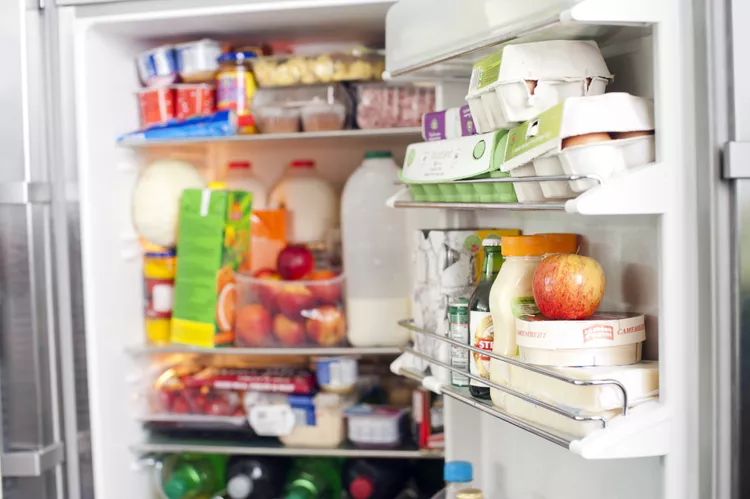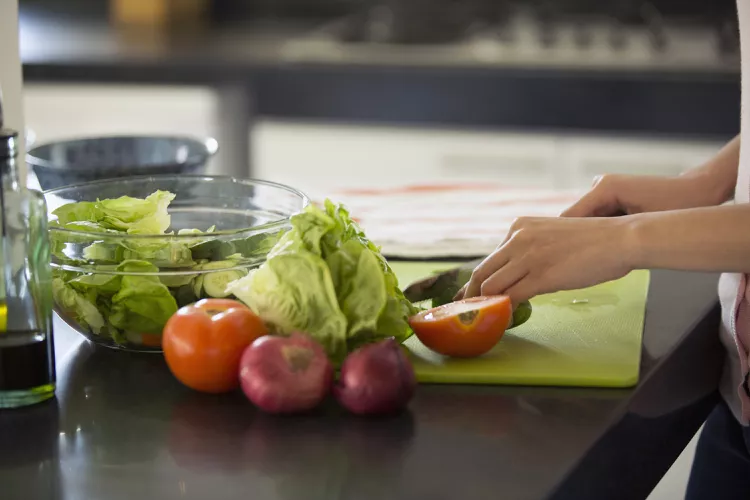
The kitchen may be the heart of a home, which is often why it’s also the dirtiest place in a home. There’s the obvious mess—like used dishes, a sticky floor, or a crusty oven. But oftentimes, there are areas and objects that are overlooked, so ask yourself, are there other places you’re forgetting to clean?
Think about the areas and objects you may be using every day during food preparation. What should come to mind are kitchen counters, handles, sinks, sponges, reusable water bottles, and more. They’re often touched daily, so it’s crucial to disinfect them either every day or a few times a week to avoid built-up bacteria and cross-contamination.1
Any Knobs, Handles, and Touch Pads
Every appliance in your kitchen has some type of control panel or handle that’s touched each time it’s used. It’s important to remember to wash all those knobs, buttons, or touchpads weekly because they’ve often overlooked when we’re giving our kitchens a deep clean. Especially if you’re touching it when you’re cooking or handling raw food. Be sure to clean kitchen cabinet pulls, appliance handles, and control panels using a disinfectant wipe or spray-on disinfectant cleaner and clean cloth or paper towel.
Sink
Even though there is plenty of water running through your kitchen sink, there are likely microbes lurking on the surface, especially in the crevices where the sink joins the counter, around the drain, and garbage disposal stoppers.2
The kitchen sink should be disinfected after every meal preparation, washing dishes or at least once per day, and don’t forget the handles and faucet and the counter areas near the sink. They catch all of the splatters when you rinse off contaminated foods.Use a sink cleaner that contains a disinfecting agent and a clean towel or disposable disinfectant wipes.
Sponges, Brushes, and Dishcloths
In an effort to reduce the use of paper towels and their impact on the environment, many homes use cellulose sponges, sink scrubbing brushes, and fabric dishtowels. Unfortunately, kitchen sponges and cleaning brushes harbor high bacterial levels, if not properly washed and disinfected.3
If you use these products, they should be washed in hot water after each meal preparation or cleaning session. Sink and vegetable scrubbing brushes can be placed in the dishwasher for thorough cleaning after each use.
Refrigerator

We’ve already discussed what can lurk on refrigerator handles and touchpads, but even with the cold temperatures, some pretty harmful bacteria can actually grow inside your fridge.4
Most fruits and vegetables will stay fresh longer if they are not washed before storing. In this case, it’s better to store them unwashed to avoid quick spoilage, but it’s important to wash the drawers often to avoid future contamination because food residues or bacteria can be left behind.5
The same thing happens with raw meat that is stored in the refrigerator. Packaging leaks and fluids accumulate in the drawers and along the edges of shelves. Even packaged products like milk or tubs of butter have been handled and stored numerous times before they enter your refrigerator.
To get rid of any kind of bacteria, as well as yeast and mold that can be grown there, remove refrigerator drawers or shelves—if possible—monthly and wash the surfaces with mild detergent and hot or warm water. Dry with a clean cloth or paper towel.
Between thorough cleanings, wipe away any spills and give the interior surfaces a quick wipe with a disinfecting wipe.
Additionally, take the extra few steps of dusting the top of the appliance and vacuuming behind and underneath as well. Remove the vent cover to vacuum the coils. Dust on coils makes the refrigerator work harder to stay cool, using more energy, and food particles hiding underneath are insect magnets.
Cutting Boards

Cutting boards, especially wooden boards, can harbor bacteria in the tiny nooks and crannies that appear after even a single use. It is important to have at least two separate cutting boards: one for fruits and vegetables and one for meats. This will reduce cross-contamination during meal preparation.6
Wash each board after every use with hot, soapy water and rinse well with hot water. Then dry completely with a paper towel or clean dish towel. Do not leave the boards to drip dry because bacteria love a warm, moist environment. You can also choose cutting boards that can be placed in a dishwasher for a thorough cleaning.
Coffee Maker, Blender, & Small Appliances
Even clean water that lingers in a warm, moist environment like a coffee maker can create a perfect environment for bacteria, yeast, and mold to grow.7 Some small appliances must be cleaned after every use. At least weekly, disassemble and clean small appliances thoroughly. Some components are safe to place in the dishwasher and others should be washed in hot, soapy water and then rinsed in hot water and dried completely.
The same cleaning routine should be applied to utensils like can openers, measuring spoons, and cups.
Reusable Lunch Boxes, Shopping Bags, & Water Bottles
Each time you use a resealable container or reusable lunch box, shopping bag, or water bottle, there is a potential for cross-contamination from bacteria, unless it has been cleaned correctly.8
The containers should be completely dissembled and placed in the dishwasher or washed in hot, soapy water, rinsed in hot water, and dried completely. Most lunch boxes and reusable shopping bags can be tossed in the clothes washer for a thorough cleaning.
An additional tip for the shopping bags is to keep them separated—designate one or more for cleaning supplies, one for raw fruits and vegetables, one for raw meat, and one for packaged goods.
Countertops
Don’t neglect your kitchen counters—they’re often the areas where purses, shopping bags, and other items are placed daily on top of it being a place to prepare food.
Grab a disinfectant wipe or clean cloth and disinfectant spray, and clean before preparing food or at least once per day. Skip the sponge or used dishcloth because they may be harboring bacteria and germs.9
At least weekly, take time to get into corners, under small appliances, and along the edges between the stove or refrigerator and countertop. You don’t want to imagine what is hidden in those moist, dark spaces.
Salt and Pepper Shakers
One last dirty spot to consider is the kitchen salt and pepper shakers. Shakers are often used and frequently touched during food preparation. Give them a careful wipe down with a disinfecting wipe after every meal preparation and a thorough cleaning every week.

This article is eye-opening! I never realized just how many dirt-prone spots there are in the kitchen. From the sink drain to cutting boards and refrigerator handles, it’s essential to stay vigilant with cleaning these areas regularly. Thanks for the reminder and the helpful tips on how to keep our kitchens clean and hygienic!
I appreciate the insights shared in this article about the dirtiest places in the kitchen. It’s alarming to learn about the potential bacterial hotspots like kitchen sponges and refrigerator seals. The practical advice provided, such as using disinfectant wipes and washing kitchen towels frequently, is invaluable for maintaining a healthy cooking environment. Definitely going to step up my cleaning routine after reading this!
This eye-opening article on ‘The 9 Dirtiest Places in Your Kitchen’ serves as an important reminder of the hidden sources of germs and bacteria in our homes. The detailed exploration of commonly overlooked areas, such as refrigerator seals and kitchen sponges, highlights the importance of thorough cleaning routines. I appreciate the practical tips provided for sanitizing these dirty spots effectively, including using disinfectants and hot water. Moreover, the emphasis on food safety and preventing cross-contamination underscores the significance of maintaining a hygienic kitchen environment. Overall, this article serves as a valuable resource for promoting cleanliness and reducing the risk of foodborne illnesses in the home.
As someone who takes pride in maintaining a clean kitchen, I found this article on ‘The 9 Dirtiest Places in Your Kitchen’ to be both enlightening and concerning. The insights provided into the potential sources of germs and bacteria in our cooking spaces are eye-opening and serve as a wake-up call to the importance of thorough cleaning. I appreciate the practical advice offered for tackling these dirty spots effectively, such as using vinegar solutions and bleach for disinfection. Additionally, the reminder to regularly replace kitchen sponges and scrub brushes reinforces the importance of hygiene practices in preventing the spread of illness. Overall, this article has inspired me to review and improve my cleaning routines to ensure a healthier kitchen environment for myself and my family.
Discovering the dirtiest places in my kitchen is eye-opening, prompting me to prioritize cleaning and disinfecting those areas regularly to maintain a hygienic environment.
Understanding the potential bacteria hotspots in my kitchen motivates me to adopt better cleaning habits and pay closer attention to overlooked areas to ensure food safety and prevent cross-contamination.
Learning about the dirtiest places in my kitchen serves as a reminder to implement thorough cleaning routines and invest in effective cleaning products to keep my family safe from harmful germs and bacteria.
Knowing the dirtiest places in your kitchen can help you prioritize cleaning tasks and maintain a healthier environment for food preparation.